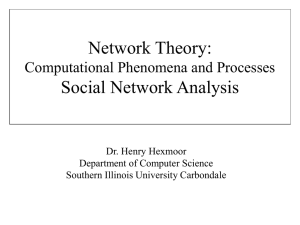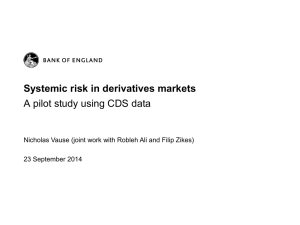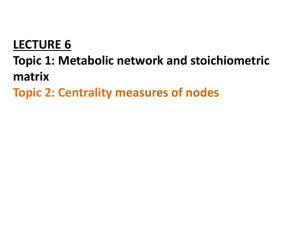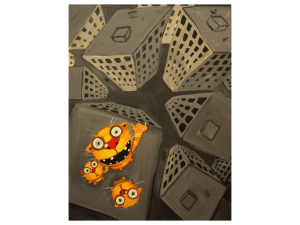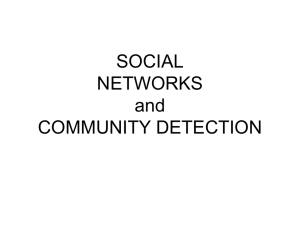20120313_A Set of Me..
advertisement
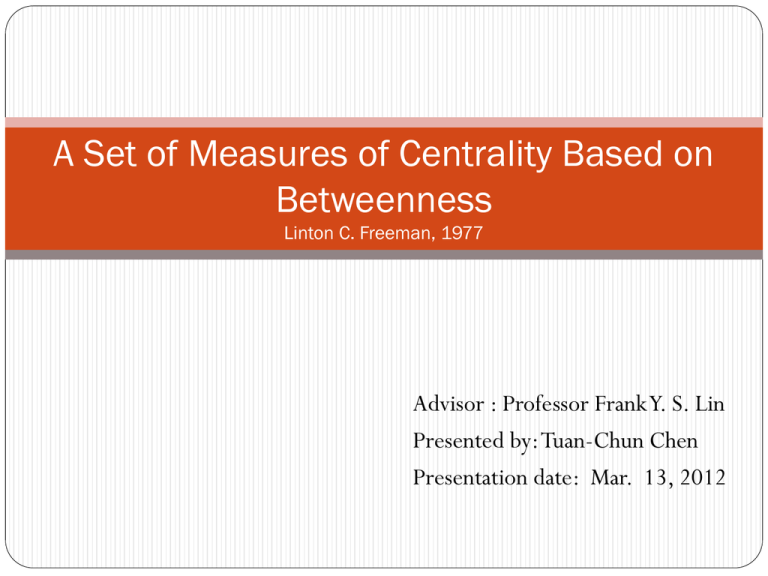
A Set of Measures of Centrality Based on
Betweenness
Linton C. Freeman, 1977
Advisor : Professor Frank Y. S. Lin
Presented by: Tuan-Chun Chen
Presentation date: Mar. 13, 2012
Agenda
Introduction
Measuring point centrality
Measuring graph centrality
Applications
Agenda
Introduction
Measuring point centrality
Measuring graph centrality
Applications
Introduction
Betweenness : A point in a communication network is
central to the extent that it falls on the shortest path
between pairs of other points. (Bavelas, 1948)
Another viewpoint by Shimbel (1953): If we count all of the
minimum paths which pass through a site, then we have a
measure of the ‘stress’ which the site must undergo during
the activity of the network.
Agenda
Introduction
Measuring point centrality
Measuring graph centrality
Applications
Measuring Point Centrality
Shaw (1954)
Unordered pair of points {pi, pj}
{pi, pj} are Unreachable or there are one or more paths
between them.
pk
pi
pj
Measuring Point Centrality
A point falling between two others can facilitate, block,
distort or falsify communication between the two.
But if it falls on some but not the shortest path connecting a
pair of points , its potential for control is more limited.
pk
pi
pj
Measuring Point Centrality
Define “partial betweenness”
If pi and pj are not reachable from each other, pk is not
between them. let
bij ( p k ) 0
If pi and pj are reachable.
bij ( p k ) (
1
g ij
)( g ij ( p k ))
gij
The number of geodesics linking pi and pj.
gij(pk)
The number of geodesics linking pi and pj that contain pk.
Measuring Point Centrality
p2 and p4 each have a probability of ½ of falling between p1
and p3.
b13 ( p 2 ) ( 1 )(1) 1
2
2
p3
p2
p4
p1
Measuring Point Centrality
Determine overall centrality of a point:
n
cB ( pk )
n
b
ij
( pk )
i j i j
CB(pk)
An index of the over all partial betweenness of point pk.
n
The number of points in the graph.
Measuring Point Centrality
Its magnitude depends upon two factors:
1) the arrangement of edges in the graph that define the
location of pk with respect to geodesics linking pairs of points.
2) the number of points in the graph.
Measuring Point Centrality
Problem ! ?
Example:
A graph containing 5 points, CB(pi)=6.
A graph containing 25 points, CB(pj)=6.
They have the same potential for control in absolute terms,
but differ markedly in their relative potential for control.
Measuring Point Centrality
Maximum Value:
C m ax
[ n ( n 1)]
2
pk
n
pi
pj
ph
n 3n 2
2
[ n 1]
2
The number of points in the graph.
Measuring Point Centrality
The relative centrality of any point in a graph, expressed as a
ratio :
C 'B ( p k )
2C B ( pk )
n 3n 2
2
, 0 C 'B ( p k ) 1
When C’B(pk)=1, the graph is a star or a wheel.
Agenda
Introduction
Measuring point centrality
Measuring graph centrality
Applications
Measuring Graph Centrality
A network is central to the degree that a single point can
control its communication.(Measures of graph centrality
based upon the dominance of one point.)
n
C 'B
[C
B
'( p k *) C B '( p i )]
i 1
n 1
, 0 C 'B 1
C’B(pk*)
The largest centrality value associated with any point in the graph.
C’B(pi)
The centrality value of pi
n
The number of points in the graph.
Agenda
Introduction
Measuring point centrality
Measuring graph centrality
Applications
Applications
Original application was in the study of communication in
small groups. Speed, activity and efficiency in solving
problems and personal satisfaction and leadership in small
group setting(Leavitt 1951).
Study of the diffusion of a technological innovation in the
steel industry(Czepiel 1974)
Examined the impact of centrality on urban growth(Pitts
1965).
Discussing the design of organization(Beauchamp
1965)(Mackenzie 1966)
Applications
Consider the relationship between point centrality and
personal satisfaction in Leavitt’s(1951) study of small group
problem solving.
Each participant had a piece of information necessary for the
solution of a problem. Each could communicate only with
designated others.
Leavitt measured point centrality as a function of the lengths
of paths or the distance between points.
Applications
Thanks for your attention!




